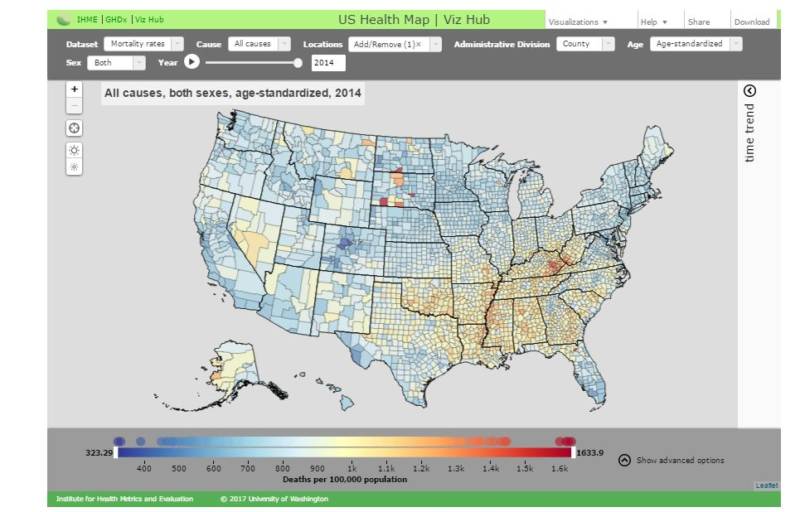On Monday an analysis was published in JAMA Internal Medicine that showed a growing gap between counties with the highest and lowest life expectancy.
The paper, from researchers at the Institute for Health Metrics and Evaluation, revealed that 13 counties have shorter expected lifespans than their parents did.
Citizens of Aglala Lakota County, South Dakota who were born in 2014 have an average life expectancy of 66.8 years, the lowest in the nation. That's lower than the life expectancy in Sudan, India and Iraq, IHME said. The county includes the Pine Ridge Native American reservation.
Various counties in Appalachia, parts of the southeast and other counties in South Dakota also fared poorly.
Parts of central Colorado had the highest life expectancy.
From 1980 to 2014, these counties had the greatest increase in life expectancy:
- Aleutians East Borough, Aleutians West Census Area, Alaska (+18.3%)
- North Slope Borough, Alaska (+17.9%)
- New York County, New York (+15.2%)
- Sumter County, Florida (+13.8%)
- San Francisco County, California (+13.5%)
- Kings County, New York (+13.2%)
- Kodiak Island Borough, Alaska (+13.2%)
- Northwest Arctic Borough, Alaska (+12.8%)
- District of Columbia, District of Columbia (+12.8%)
- Loudoun County, Virginia (+12.4%)
And the worst decreases:
- Owsley County, Kentucky (-3%)
- Lee County, Kentucky (-2%)
- Leslie County, Kentucky (-1.9%)
- Breathitt County, Kentucky (-1.4%)
- Clay County, Kentucky (-1.3%)
- Powell County, Kentucky (-1.1%)
- Estill County, Kentucky (-1%)
- Perry County, Kentucky (-0.8%)
- Kiowa County, Oklahoma (-0.7%)
- Perry County, Alabama (-0.6%)
In January a study published in JAMA highlighted the geographical disparities within the U.S. regarding cancer death rates. Researchers at the Institute for Health Metrics and Evaluation looked at the country's more than 19.5 million cancer deaths in every one of 3,144 U.S. counties from 1980-2014. The study found that while the overall cancer mortality rate decreased by about 20 percent, in 160 counties the rate actually increased.
All of the data from the latest studies and more are incorporated into IHME's U.S. Health Map, launched in 2013 with a look at mortality rates by county. Since then the institute has supplemented the map with additional data as more research has been conducted. Big data geeks, health researchers, and those with a morbid propensity to delve into who-dies-where-from-what have been parsing the data, which includes live expectancy, mortality rates and different risk factors, ever since.
Click on the image for the map. Not a great experience on mobile, so you may want to bookmark or send to yourself for later viewing.
The Institute for Health Metrics and Evaluation on Monday released another in a series of its big-data analyses of who-dies-where-from-what, and like so much else in the country, the news is good or bad depending on where you live.
The analysis, published in JAMA Internal Medicine, showed a growing gap between counties with the highest and lowest life expectancy.
The study from IHME researchers revealed that in 13 counties, residents have shorter expected lifespans than their parents did.
Citizens of Aglala Lakota County, South Dakota who were born in 2014 have an average life expectancy of 66.8 years, the lowest in the nation. That's worse than the life expectancy in Sudan, India and Iraq, IHME said. The county includes the Pine Ridge Native American reservation.